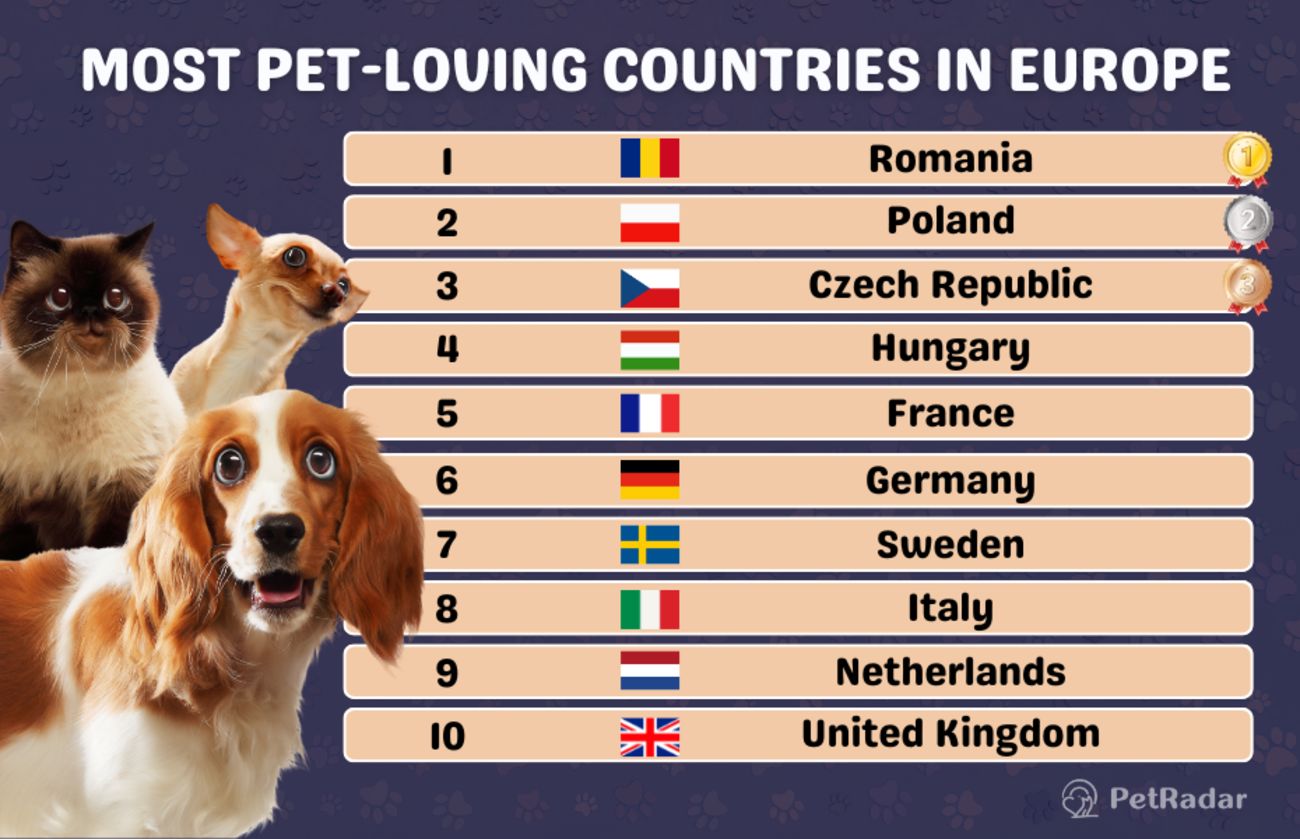Key Takeaways
Romania ranks #1 in Europe for pet ownership with 48% of households owning cats and 45% owning dogs, the highest combined rate on the continent.
Germany was the first country in the world to guarantee animal rights in its constitution (since 2002).
The Netherlands officially declared "no more stray dogs" after a century-long humane effort to eliminate abandonment.
Over 90% of Swedish pets are insured, the highest known pet insurance rate globally.
78% of French pet owners say their pets are indispensable to happiness.
The UK pioneered animal welfare in 1824 with the founding of the RSPCA — the world's first animal protection charity.
68% of Hungarians say pets improve their social life and reduce loneliness.
The Czech Republic has more dogs than children under age 10, earning it the nickname "The Dog Republic."
79% of Italian pet owners consider their pets family members, with this sentiment rising to 85% among Millennials.
Quick Navigation
Across the continent, from the sun-drenched hills of Tuscany to the snow-laced streets of Stockholm, Europeans are embracing their pets as family members. 🐕🐈 Cats lounging on Roman ruins, dogs riding the Paris Metro like seasoned commuters, and entire cities where pets are treated like tiny, furry VIPs.
1. Romania: The Reigning Pet Kingdom
🐱 Cats: 48% of households
🐶 Dogs: 45% of households
(One of the highest pet ownership rates in Europe!)
Moderate but improving: Romania is set to ban fur farming by 2027.
Lately there's been a stronger push to stop illegal breeding and tougher penalties for those who mistreat animals.
High rates of adoption from shelters.
Very strong rescue movements. NGOs are extremely active, especially for dogs.
Public attitude is shifting from "guard dog" to "beloved companion."
Growing number of pet-friendly cafes in Bucharest and Cluj.
Future plans for allowing pets in public institutions are under discussion.
Pets are allowed on public transport, as long as they are on a leash or in your arms.

2. Poland: Paws Everywhere
🐱 Cats: 40% of households
🐶 Dogs: 49% of households
Solid progress: Stricter animal welfare laws passed in recent years.
Newer laws regulate breeders and strengthen penalties for abuse.
Strong regional adoption programs and awareness campaigns.
Pets often appear in TV ads and public campaigns as family figures.
Expanding dog parks in major cities like Krakow and Gdańsk.
Pet-friendly cafes and co-working spaces are on the rise.
3. Czech Republic: The Dog Republic
🐱 Cats: 31% of households
🐶 Dogs: 42% of households
High: Strong enforcement of anti-cruelty laws.
Recent focus on preventing puppy mills and regulating breeders.
Dogs are treated like tiny humans. They join for beers, hikes, and family vacations.
Strong vet care culture and annual pet expos.
Cats are popular in both apartments and countryside homes.
Pets allowed on public transport (small ticket fee or free if carried).
Dogs allowed in most restaurants, cafes, and even castles!
Prague ranked one of Europe's top cities for traveling with pets.
4. Hungary: Tail-Wagging Nation
🐱 Cats: 33% of households
🐶 Dogs: 39% of households
Strong: 2022 legislation introduced new standards for breeding, shelter care, and tougher penalties for abuse.
Bans on chaining dogs long-term and mandatory registration for breeders.
68% of Hungarians say pets improve their social life and reduce loneliness.
"Kutyanap" (Dog Day) celebrations and pet-friendly music festivals are a hit.
Pet expenditure has risen 33% over the past 5 years
Dogs allowed on most public transport (leash required).
Budapest has over 30 dog parks and several dog-friendly spas.
Increasing number of pet-friendly apartment complexes and cafes.
5. France: Chic Companions
🐱 Cats: 34% of households
🐶 Dogs: 28% of households
High: In 2021, France legally recognized pets as living beings "endowed with sensitivity."
Tight regulations on pet sales; stronger controls on breeding.
78% of French pet owners describe their pets as "indispensable" to happiness.
Pets appear regularly in marketing, from high fashion to car commercials.
Adoption campaigns like "Adoptez-moi!" are mainstream media events.
Dogs are welcome in many restaurants, bakeries, and on public transport.
Dog beaches and dog-friendly hotels abound in the south of France.
France even has doggy wine on some menus (non-alcoholic, of course).

6. Germany: Organized Affection
🐱 Cats: 30% of households
🐶 Dogs: 21% of households
Excellent: Germany was the first country to guarantee animal rights in its constitution (2002).
Bans on cosmetic surgeries (ear cropping, tail docking).
Pets are legally recognized as sentient beings rather than property, a distinction that gives them special protection under the law.
Dog behavior training is widespread and culturally encouraged.
Germans spend €6 billion annually on pet care.
Pets allowed on trains and public transport (often free or very cheap).
Munich, Berlin, and Hamburg have huge pet-friendly parks.
Many employers allow dogs in offices ("Bürohunde" = office dogs).
7. Sweden: Nordic Pet Paradise
🐱 Cats: 19% of households
🐶 Dogs: 15% of households
Top-tier: Sweden scores among the best globally for animal rights.
Strict laws on breeding, housing, and veterinary care standards.
90%+ of Swedish pets are insured!
"Hunddagis" (dog daycares) are as normal as preschools for kids.
Hiking with dogs ("friluftsliv" culture) is a huge national pastime.
Pets allowed in public transport (some even have their own seats!).
Pet-friendly nature reserves and lakes all over the country.
Many cities have "hundbad" — dedicated dog swimming beaches.

8. Italy: La Dolce Vita with Pets
🐱 Cats: 30% of households
🐶 Dogs: 27% of households
Strong: Italy banned euthanizing healthy animals in shelters back in 1991.
Recent laws are pushing to stop illegal puppy trafficking.
Cosmetic surgeries (tail docking, ear cropping) banned except for medical reasons.
79% of Italian pet owners consider their pets family members, with this sentiment rising to 85% among Millennials.
Cities like Rome have massive cat colonies cared for by volunteers (called "gattare" — cat ladies!).
Pet-friendly religious services exist — you can even have your dog blessed by a priest on Saint Francis of Assisi Day.
Dogs allowed in many restaurants, trains, and hotels without extra charges.
Milan officially allows dogs in all public offices and hospitals (if on a leash/muzzle).
Pet boutiques and "gelato for dogs" parlors are gaining popularity in major cities.
9. Netherlands: Two Wheels, Four Paws
🐱 Cats: 27% of households
🐶 Dogs: 20% of households
Excellent: Strong anti-abuse laws; great national spay/neuter campaigns.
Cosmetic surgeries banned; breeders must meet strict ethical codes.
Netherlands famously declared "no more stray dogs" after a century-long humane effort.
A significant part of Dutch pet owners consider their pets as family members
High rate of pet adoptions compared to purchases from breeders.
Animal rights parties (like "Partij voor de Dieren") even sit in Parliament!
Pets allowed on buses, trams, and trains (small fee or free if small enough).
Huge number of urban parks and pet play areas ("hondenspeelweides").
Amsterdam boasts pet-friendly canalside hotels and even pet boat tours!

10. United Kingdom: Royal Companions
🐱 Cats: 26% of households
🐶 Dogs: 25% of households
Excellent: the UK consistently scores among the top countries in the World Animal Protection Index.
Laws ban puppy farming, tail docking, and non-medical declawing.
Stray animals are rare thanks to strong rescue and microchipping policies.
90% of pet owners in the UK view their pets as part of the family.
Britain was the first country to create an animal welfare charity (the RSPCA, founded in 1824!)
Major events like "Bring Your Dog to Work Day" and "National Pet Month" are huge, heartfelt events.
Dogs are allowed on most public transport, including the Tube in London.
Many pubs, cafes, and even boutique hotels offer water bowls, treats, and doggie menus.
Rental laws have been evolving too — tenants now have stronger rights to keep pets.

Fun Facts 🐾
Romania has one of the highest stray dog rescues rates in Europe thanks to passionate NGO work. Some shelters even export dogs for adoption abroad!
Poland hosts "Dog's Day" every July, where public squares transform into puppy playgrounds complete with adoption fairs and obedience demos.
Czech Republic has more dogs than children under the age of 10! No wonder it's nicknamed "The Dog Republic."
Hungary is home to the "Vizsla" — one of Europe's oldest and most adored dog breeds, famous for their gentle nature and loyalty.
France has a legendary reputation for allowing dogs in cafés — but did you know some Parisian bistros have a "doggie menu" offering beef tartare... for dogs? (No Michelin stars yet, though.)
Germany considers pet ownership a serious responsibility. You have to pay an annual "dog tax" (Hundesteuer) in many cities, but the money funds dog parks and animal welfare.
Sweden invented the concept of doggy daycare ("Hunddagis") — and many offer enrichment classes like "How to Use Your Nose" (scent work).
Italy even has Pet Days in some regions where museums open their doors to four-legged visitors for free. Furry art critics, anyone?
Netherlands has bike lanes so pet-friendly that it's normal to see a dedicated basket or trailer carrying a happy dog on two-wheeled adventures.
United Kingdom pets are so adored that the Queen's Corgis had their own butler... and even a personal Christmas stocking at Windsor Castle.

Long Live Europe's Furry Monarchs

Eurostat
GlobalPetIndustry
Romania Insider
WorldFood Poland
TGMStatbox
TGM Global Pet Survey 2023
Travelnuity
Czech Statistical Office
Daily News Hungary
Global Pet Industry
Bürgerliches Gesetzbuch
German Constitution Amendment (2002)
PR Newswire
Unipol + IPSOS 2024
DutchReview
Sky News



